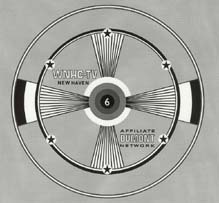I was always an early riser as a boy, even on Saturday mornings—or maybe especially on Saturday mornings. The house was quiet as I rushed downstairs to the den, where our television was located. In those days, we could only get one channel clearly, Channel 8 from New Haven (originally Channel 6). I don’t think Hartford’s Channel 3 was on the air yet, and even after it did join the modest lineup, our reception of it was iffy. As for New York channels, we could only pick them up, briefly and unreliably, during atmospheric oddities, such as increased sunspot activity or the transit of Venus.
In any event, I’d get downstairs and turn on the set, and this is usually what I got to see:

It’s called a test pattern. In the days when TV channels did not run programming for 24 hours, they put up the pattern during the period (usually in the middle of the night) when they were off the air. So, depending on how early I was awake, I’d watch the test pattern for 10 minutes, 20 minutes, even a half-hour. The image was accompanied by a high-pitched tone that I still associate with boredom, impatience and anxiety. And then abruptly at 6 a.m., the test pattern would disappear, replaced by an image of a waving American flag and the playing of The National Anthem, which would signal the beginning of the broadcasting day. Real viewing would next commence with 15 minutes of union propaganda called “Industry on Parade,” an episode of “The American Farmer” or the early, early show I remember most fondly, a cartoon called “Crusader Rabbit.”
The thing is, as much as I happily recall Crusader, Rags the Tiger and their doings down in Gallahad Glen, it’s the test pattern that has stayed with me most clearly—and that I appreciate today for its unique blend of art and implied technology. Take a look at the test patterns collected here and tell me they aren’t beautiful, mysterious and high-tech all at the same time. If I had Jasper Johns’ talent, I’d bag the American flags and paint test patterns instead.
